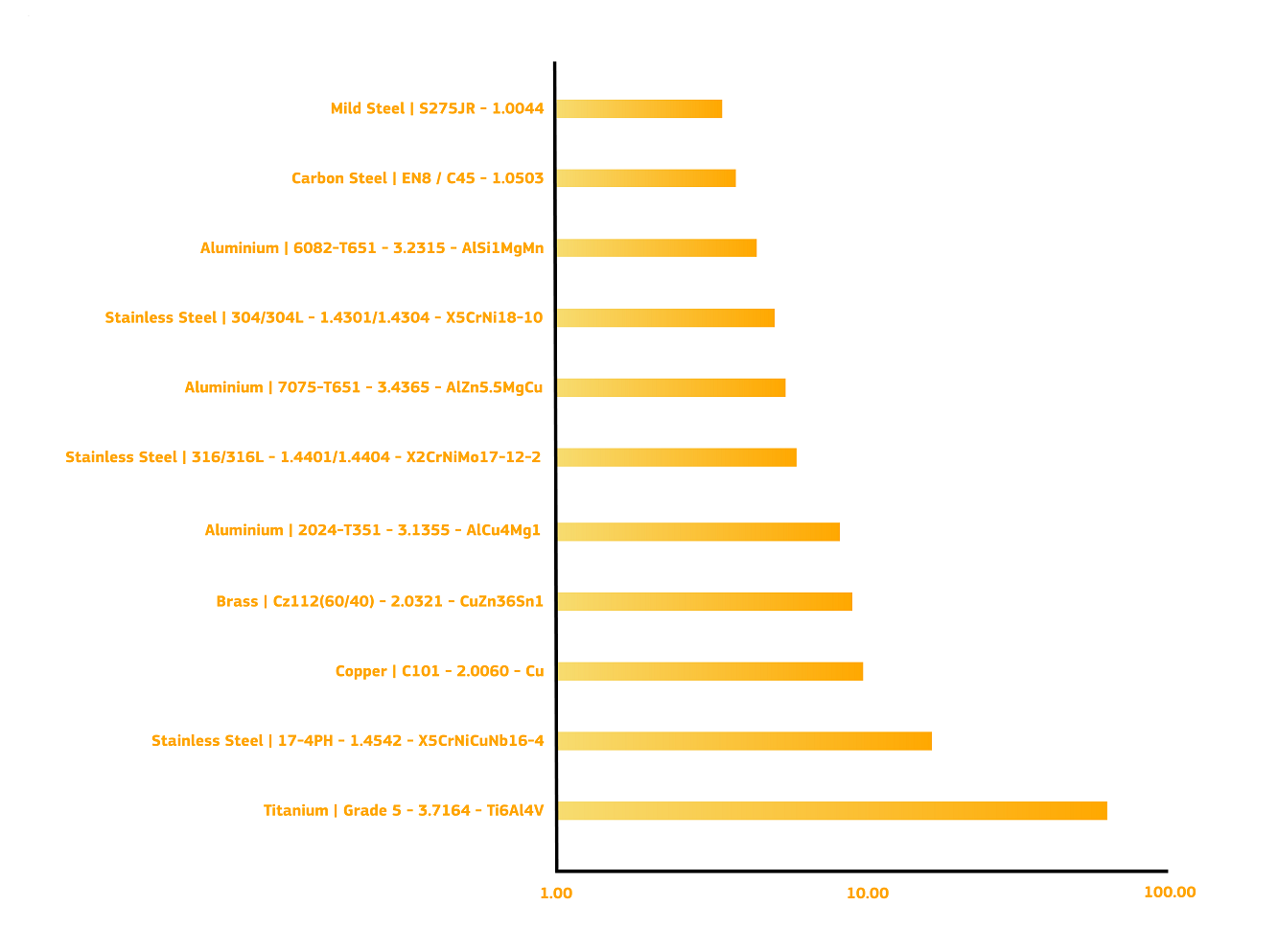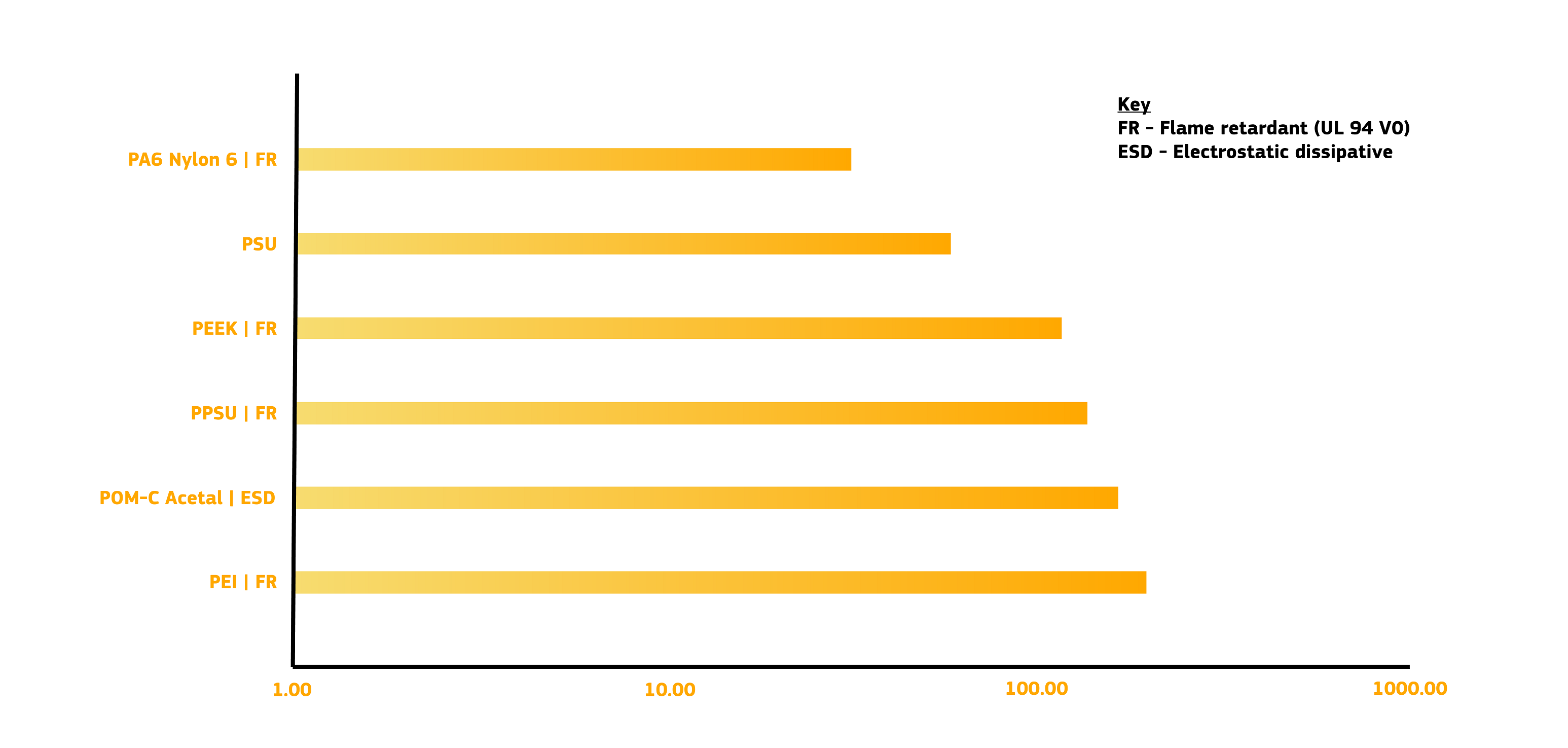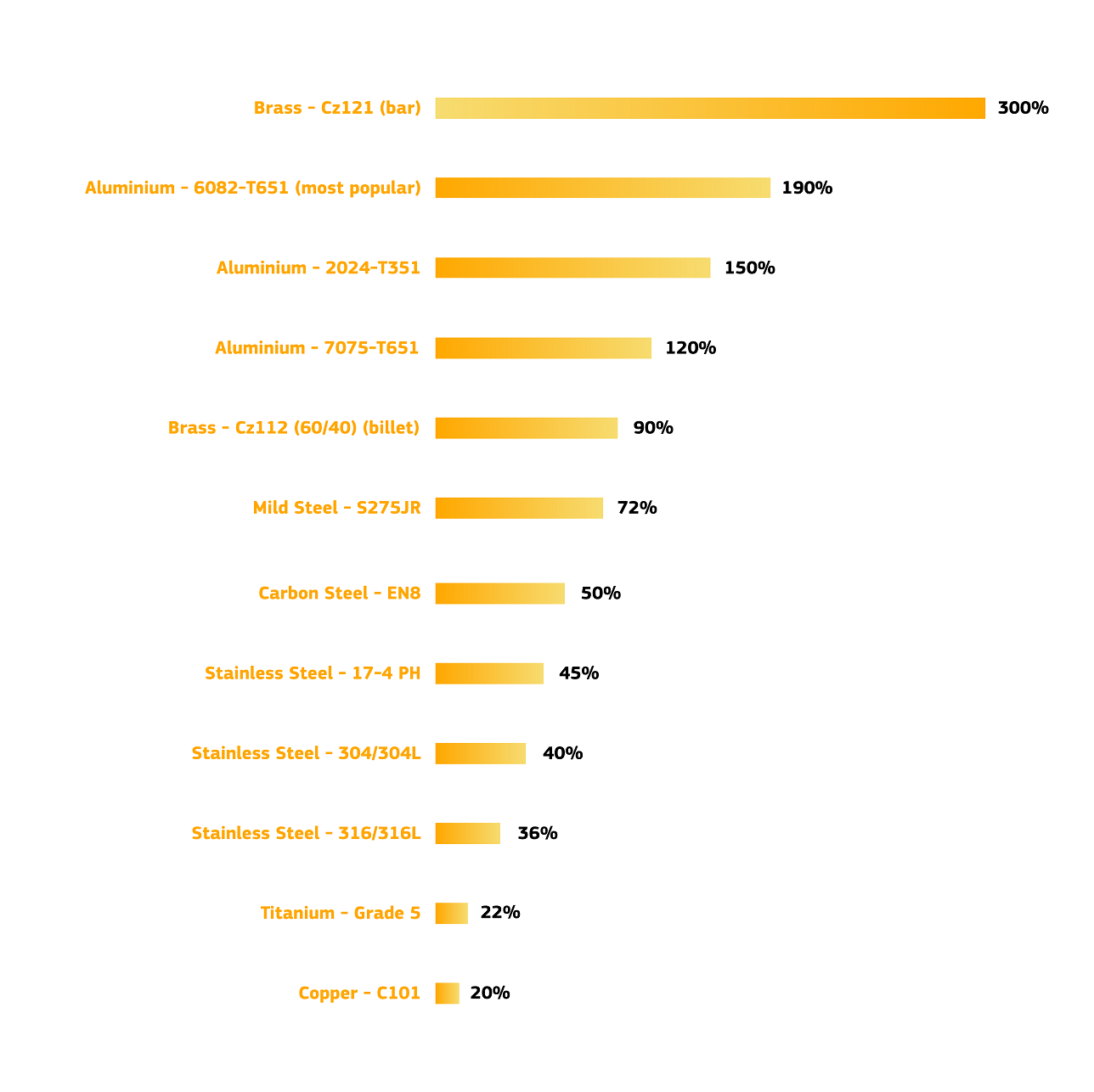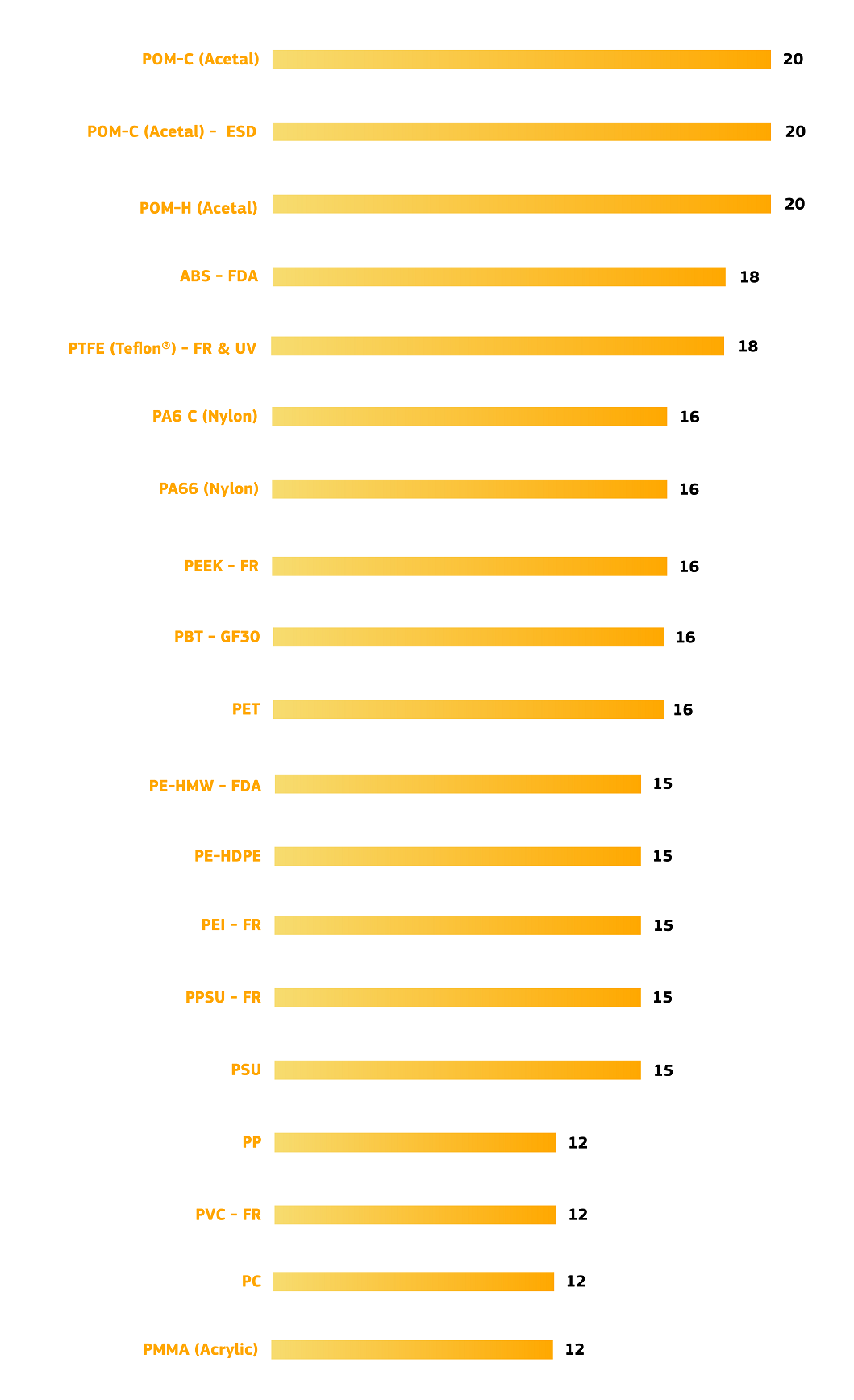It is a common question: “how much will it cost me, and how much does it cost to make?” We all like a bargain! Also, we are all good at pricing up the things we buy – “£5 for a pint of milk? No way!” But when it comes to custom made components, whether manufactured by CNC, 3DP or IM, things get a bit more complicated.
It can be simplified a little by thinking about the big three factors: Raw material, manufacturing time and ‘fixed’ or other costs. See how each element contributes to a price:
Raw material
Metals: gold, silver, bronze – we all know that mineral scarcity and refinement costs (embodied energy and manufacturing techniques) dictate the raw material cost. The graph of relative metal costs has few surprises – steel and aluminium are abundant (Al6082 is our most common grade) and have the lowest raw material cost per kg (or pound). The middle of the graph includes the more specialist aluminium and stainless steels that contain expensive alloying elements. Finally titanium, which is surprisingly abundant, but difficult to refine (which also contributes to its high price but also properties like corrosion resistance).
Plastics: on the other hand can look quite similar, but have an even more extreme price range.
- Lower cost per kg: Nylon (PA6), acrylic and ABS are workhorse materials; used extensively in injection moulding as well as CNC components. However, there is a material that may work out both cheaper and have better performance. Acetal (often referred to a Delrin®) is a great general purpose engineering plastic with good stability.
- Medium cost: You will pay about 50% more for glass-filled grades – the brittle but fragile properties of glass fibre, combined with the tough plastic, creates a composite. Which is stronger and harder wearing.
- Specialist: these raw materials exceed the price of titanium (can be over £100/kg) so worth checking if you can use an alternative first! Generally they are required to meet a specific need: PC (polycarbonate) is so strong it is used for bullet proof glass! PEEK – the go-to choice for F1 and aerospace, stronger than some metals, UV and flame resistant it can cope with almost any demand. PSU, PPSU, PEI are generally used in food and medical applications. Finally, POM-ESD is modified to be just conductive enough to prevent static discharge.
Manufacturing cost
This is made up from machining time (and the associated tool wear) as well as time to make fixtures to securely hold the components, and setups – where machining takes place from multiple directions.
We don’t fabricate a cost, we fabricate your part (digitally) and factor this into the price. This is so we are sure it can be made and have considered how long it will take – we offer same day service for less complex parts, and most of our quotes are eligible for a 3-day turnaround. We mostly do this automatically, but an experienced engineer also signs off every quotation. This generally takes less than an hour.
Naturally, part complexity plays a role – smaller, more detailed features need smaller tools and so take longer. However, the other factor is machinability.
Generally, plastics are softer and easy to machine – but too soft can present challenges – PVC and PP (polypropylene is well known for making ropes and exhibits this behaviour when cutting). The next best are the ‘soft’ metals – brass and aluminium 6082. Generally the harder the metal, the harder it is to cut. Finally copper is very malleable – so avoid thin features.
Ref https://www.azom.com/article.aspx?ArticleID=4097
Other and fixed costs
There are always additional costs. But often they are not ‘value added’ (don’t directly contribute to making the part) but necessary (and important); packaging, gauging and inspection, calibrating and setting up the equipment, work holding, preparing quotations and communicating with customers.
One way to minimise these is automation, robotics and autonomous machines set up for high volume immediately spring to mind. This type of automation is great at reducing the piece part price, but that in itself comes at a cost known as Non-Reoccurring Engineering (NRE) cost. In other words it takes time to setup and can be inflexible. Great if you are making 1000s but not much use for prototyping and first-off production quantities.
That’s why our automation is focused on the NRE, using a digital thread. We don’t need a 2D drawing, because we automatically generate the machine code, inspection requirements, and work piece holding directly from your upload. The main advantage of this is that we can start making your 3D design within minutes of order. The second advantage is you won’t see a setup fee. Sure, there is a reduction in price with each additional part but we are really flexible at making complex parts, smaller batches and one-offs.
Are you comparing like for like - what else is included in a price?
So far, we have talked about the physical attributes – material, size and quantity. However, there are other invisible attributes included in our manufacturing service: speed and reliability.
All of the European CNC components are made in the UK, with additive manufacturing in Germany. Our median CNC manufacturing time is 3 days.
It is a miracle of modern transport and global commerce that if you can wait 3 weeks or 3 months there is a whole world of options. Just be sure you are comparing ‘price and delivery’ on a like-for-like basis. Which brings us to the final point.
Thinking about value, over focusing on cost
“Time is money” as the saying goes, and your time is especially valuable. Whatever you are designing will make an impact, and your customers want it now. We have helped prototype and manufacture everything from better medical devices and more efficient electrical equipment to better transport solutions.
It’s likely that spending 10% more on solid prototyping and testing will pay back with a better product, but, turning up 10% late (or say 10 days after a major product launch!) is a costly problem.
“Fail fast, fail often”, was Thomas Edison’s quote (and he did! with over 9,000 prototypes). Dyson famously produced over 5,000 prototypes perfecting the cyclone vacuum cleaner. Using 3D CAD and digital tools designers no longer need to test as much, but perhaps the balance has swung too far? It really is so quick and easy to upload.
Finally, consider:
- Quality factors: components meet and exceed the stated tolerance
- Service: protolabs.com/en-gb has information on material properties, design tips and thread selection
- Advice: each quote has 3D design feedback and our Customer Services Team are ready to go the extra mile to provide you with advice and information on the best manufacturing solution










